Posts filed under 'Men’s'
Guys, you no longer have to patiently wait as your girlfriend browses the endless racks of Forever 21, because you can be doing the same thing. Twenty One Mens, Forever 21’s menswear collection, launched a Spring 2006 collection with a variety of casual and tailored garments.
Don’t know where to start browsing? Check out some of our favorites.
What have we said about Birds on Shirts?
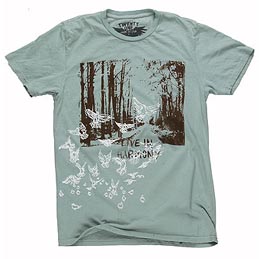
Harmony Tee Shirt| $14.80 at Forever 21
Looks like something Grandpa would wear…only cuter.
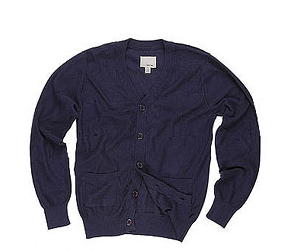
2 Pocket Cardigan | $22.80 at Forever 21
A clean departure from the Striped Shirt.
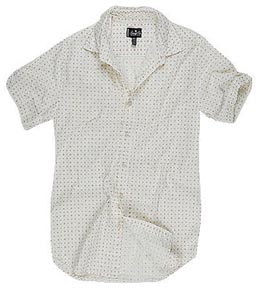
Short Sleeve Printed Button Down Shirt | $17.80 at Forever 21
Native American gear never looked so suave.
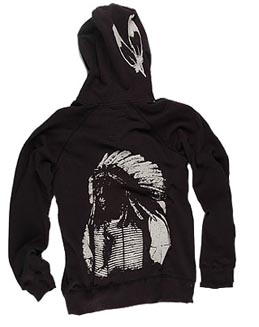
The Chief Full Zip | $27.80 at Forever 21
It’s time to spice up the tired button-down-shirt-as-formal-wear.
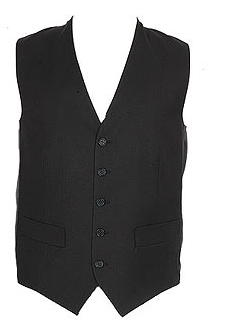
Solid 3 Button Vest | $29.80 at Forever 21
June 6th, 2006
Q: I still haven’t quite figured out shoes and belts for men. What’s the connection between shoes and a belt (one time, or, to be honest, many times I’ve worn black shoes with a brown belt and had comments flung my way)?
Also, I’m the kind of guy who only has one pair of shoes at a time — which color has more power to look professional and match khakis, brown or black? And last up, what am I doing wrong in trying to buy a belt– I walked into Nordstroms to get a black belt recently and they averaged $90, which is way above my budget. What am I to do?
A: General rule of thumb: match the belt to the shoes. So if you’re wearing a black belt, wear black shoes. If you’re wearing a brown belt, wear brown shoes. And so forth. However, this isn’t a Law.
A better rule might say match the style of the belt to the shoe. That style is most visually expressed through color–hence the "match the belt to the shoes" mantra. I wouldn’t want to pair the black and the brown, but pairings that don’t exactly match, but are similar in style are definitely A-OK.
Note also that there are formal belts, and there are casual belts. Skinny belts are usually reserved for more formal occasions, and thicker belts are more appropriate for casualwear. For casual belts, leather isn’t the only option–there’s nylon, grosgrain (ribbon), and canvas, for starters.
If you want to look professional, I’d recommend moving away from khakis and going towards black or grey pants. In your industry, though, it might be more acceptable to wear khakis. In that case, I’d recommend a darker shade of brown. For the black or grey pants, black would be the preferred option between the two.
As for buying a belt, try Macy’s. I’ve found decent quality, stylish belts in the $30-$40 range there. Other options: Club Monaco, or the everpresent Banana Republic and Gap stores.
April 29th, 2005
Q: You wrote a post about color combinations for women a little while back. What about color combinations for men?
A: Here are three color combo suggestions to spice up your wardrobe, along with suggested pant colors to accompany them. Enjoy!

Coral + Sky Blue at
Armani ExchangePair this color combination with jeans, white pants, khakis, or purplish grey pants.
Green + Blue at
Polo Ralph LaurenPair this color combination with jeans, white pants, black pants, or khakis.
Orange + Bright Blue at
American EaglePair this color combination with jeans, white pants, khakis, or purplish grey pants.
April 21st, 2005
I’ve been getting more questions via email—I’m just going to make this Q&A week! If you have a burning style question, send it my way: styleintelligence@gmail.com.
Q: Is it okay to mix metals (e.g. gold and silver) when choosing jewelry?
A: Yes, it’s okay to mix metals. However, be careful to choose some unifying theme. I’d recommend choosing pieces that are similar in style, color, or even shine. You wouldn’t, for example, want to combine a shiny platinum and a dull gold. When in doubt, there are always pieces that are made of multiple metals—these generally do a good job with the combination.
Note that the same guidelines apply for picking metallic-colored pieces of clothing.
April 20th, 2005
How did I get started?
I’ve always Loved fashion, and it’s been a dream of mine since childhood to work in the fashion industry. However, fashion wasn’t really encouraged in my family—I have traditional Asian parents that wanted me to become a doctor or a computer programmer. I was trucking along, doing the parentally approved thing, right up until my freshman year of college.
I was studying Management Science and Engineering (optimizing Stuff—it was the closest thing to a business major that Stanford had), and I knew something was missing. Not that I didn’t enjoy the business classes, but I knew that I wanted to apply them to something more creative than say, a software company. Researched some fashion schools in the Bay Area, and found the Fashion Institute of Design and Merchandising. As it turned out, they had an evening program for the Fashion Design major, specially designed for people with day jobs. I then spent the next two and a half years taking business classes during the day and fashion classes at night, graduating with an AA in Fashion Design, and a BS and MS in MS&E. I’m leaving out the ugly details of what that entailed, but suffice it to say, I didn’t get much sleep.
While going to school, I was fashion consulting. Got experience in helping people choose outfits for anything from interviews to dates to weddings. After graduation, I got my start in fashion design by showing my first collection in San Francisco’s first-ever Fashion Week in August 2004. I also continued doing fashion styling work—a recent project included styling a Hair/Fashion Show for the Patrick Evan Salon. And here I am writing a fashion blog!
Shameless Plug Alert: There’s more to come—I’ll be launching a line of clothes (men’s and women’s) later this year. More on that later.
The key takeaways here?
Don’t give up, if you really love fashion. You’re bound to run into roadblocks, but find creative solutions to overcome them. Finding a creative solution is what fashion is about anyhow, isn’t it?
Get as much experience as you can, as early as possible. While in school, volunteer for projects—helping out at local fashion shows, or interning with a designer. Learn as much as you can, both in the classroom and outside. Read fashion magazines and trade publications like Women’s Wear Daily or the Daily News Record. Broaden your fashion knowledge in any way that you can!
I took an unconventional route by going startup style (I guess it’s the Silicon Valley bug…how very 2000 of me). But hey, it’s becoming more acceptable as time goes on—just look at startup successes like C&C California. A more traditional route to becoming a designer is to intern at a company, work your way up the ladder, and eventually become a designer. Or starting your own label once you’ve established yourself at a major design house (e.g. a Calvin Klein or a Ralph Lauren). As for fashion styling, you would first intern with an established stylist, learn the ropes, and eventually break out on your own.
A Word of Warning
People aren’t kidding when they say fashion is a tough industry. Part of it I think is the inherent fickleness that fashion industry cultivates, but another part of it is due to the intense competition for jobs. I have no doubt that the slim profit margins of the industry also play a role. FYI—fashion salaries can be kind of grim. Especially when you’re starting out. Internships are often unpaid (or for little pay), and entry-level salaries aren’t so pretty either.
I wish you the best of luck, and feel free to ask follow-up questions. I’m a strong supporter of fresh design talent, and would like to advise in any way as I can!
April 19th, 2005
I got a question from OrangeBox5 about what fashion designers and fashion stylists do, and how to break into the industry.
So here’s the scoop:
Fashion Design: Fashion designers provide “creative direction†for a line of clothing—they are responsible for the look and feel of the collection, and they oversee the design process.
What is the design process? A simplified version looks like:
- Choose collection theme.
- Choose fabrics and colors.
- Sketch garment ideas.
- Refine the sketched garments, and choose the garments that will move on to the next stage: first samples.
- Make first samples.
- Test these samples through fittings on fit models.
- Refine samples, and choose those for production, using input from fashion merchandisers and retailers who have placed orders.
- Manufacture garments.
- Quality assurance: check for garments out of spec.
- Finishing & Tagging.
- Ship to stores/customers.
Things can get pretty crazy, considering that all this work needs to be done for each collection, and work is usually being done on multiple collections at the same time. The lead time from beginning to end of the design process has traditionally been about a year. This means that for a company with two collections per year (Spring/Summer and Fall/Winter), they’ll be working on both at the same time, though they’ll be at different stages of the process at any given time. Just imagine how crazy it is for companies that produce four or five collections each year!
Now, depending on the size of the company, designers will have a variety of assistants helping with the nuts and bolts of the process. There are textile specialists that source out fabrics from textile manufacturers, technicians that ensure that the fabrics are dyed the Exact Right Color, patterndrafters, sewers who sew the first samples, sketchers who translate the designer’s vision into a physical drawing, and more.
Fashion Styling: Fashion styling, or fashion consulting, involves designing a “look†for a client. Stylists don’t make the clothes—they act as editors and pick and choose what they want to create the image they’re after. Stylists can work for celebrities, for clothing manufacturers (Fun Fact: Queer Eye’s Carson worked as a stylist for Ralph Lauren), for films, and for individuals. Each job is different, but here’s an outline of how a styling job might work:
- Discuss with the client the look they’re after (and the budget for the job).
- Obtain measurements of the individual(s) you’re dressing.
- Shop! Find clothes! This has to be my Favorite part.
- Meet with the client and review the clothing selections.
- Dress the individual(s), and make any adjustments (style wise via accessories or tailoring for fit), as needed.
FYI—the sheer length of my answer motivated me to split this post into two parts. Check back tomorrow for second part of this post, which discusses how I got started in fashion, as well as advice for those who want to break into the fashion industry.
April 18th, 2005
Q: I’m a classic dresser with pretty conservative tastes, but I want to move my wardrobe into more colorful territory. Help please!
A: Considering the wide range of color options out in the marketplace right now, there’s no better time to start adding color to your wardrobe. I see three color combinations as both flattering and fashion-forward this season. What’s more, they’re relatively easy to wear without being overwhelming.
- Blue + Green: The nautical theme on the runways has manifested itself again—this time in color form. But don’t think of the high seas when choosing your ocean-inspired colors. Instead, imagine yourself on a beautiful tropical island, complete with crystal clear skies and a richly hued seascape. Try sky blue and sea green, as well as sky blue and lime green. Blue and green never looked so fresh.
“The Bottom Line†Silk Shirt ($79) and “That’s a Wrap†Silk Skirt ($99), both at Kenneth Cole.
- White + ???: While the green and white combo was tennis inspired for Summer 04, it’s still around this year in more sophisticated permutations. Though the sporty outfits were definitely cute, I’m glad green and white have moved beyond the tennis court. Judging from retail store displays, green and white is here to stay for Spring/Summer 05—look for the color combination in stripe and colorblocking forms. Also hot: turquoise and white, and light blue and white. My prediction: as much as I love green and white, sky blue and white will dominate over the next two seasons.
Theory: Striped Shirt ($165), White Tank $45, Flared Pants, $195.
Find them at Neiman Marcus.
- Pink + Grey: Pink has traditionally been paired with brown, a pretty color combination (especially when pairing a dusty rose pink with a chocolate brown) that got kind of tired by last autumn. The new It Pairing for pink? Move over brown, and make room for grey! I love a light heather grey with pretty much any pink hue, light or dark. FYI—My pile of pink tops from last summer pair especially well with the Sasha Shrunken Cable Cardigan from the “Stylish Sales†post. Try pairing that sweater with the camisole below for a fun spring look!
 Eva Lace Trim Cami ($44) at Guess.
Eva Lace Trim Cami ($44) at Guess.And for even more daring color combinations, feel free to try:
- Orange + Yellow
- Green + Yellow
- Orange + Pink
Though I started this blog only last week, I already started to receive style questions by email. Thanks for being proactive—I applaud you! I plan to write a Style Q&A post each week—so feel free to email more questions to styleintelligence@gmail.com. Hope to hear from You!
March 29th, 2005
Next Posts










